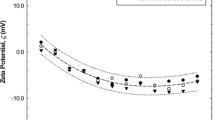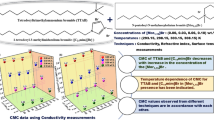Abstract
Surfactant-modified mineral surfaces can provide both a hydrophobic coating for adsorbing organic contaminants and, in the case of ionic surfactants, a charged exterior for adsorbing oppositely charged species. This research evaluates the precipitation phase boundaries and synergistic behavior of the mixtures of carboxylate-based anionic extended surfactants with a pyridinium-based cationic surfactant. One cationic surfactant (cetylpyridinium chloride) and four anionic extended surfactants were studied. The anionic surfactants studied were ethoxy carboxylate extended surfactants with average carbon chain lengths of either 16 and 17 or 16 and 18 with 4 mol of a propylene oxide group and a different number of moles of an ethylene oxide group (2 and 5 mol). Precipitation phase boundaries of mixed anionic extended surfactants and cationic surfactant were evaluated to ensure that the surface tension studies are in regions without precipitate. Surface tension measurements were conducted to evaluate the critical micelle concentration of individual and mixed surfactant systems. Precipitation phase boundaries of these novel mixed surfactant systems showed greatly reduced precipitation areas as compared to a conventional mixed surfactant system which is attributed to the presence of the ethylene oxide and propylene oxide groups and resulting steric hindrances to precipitation. Moreover, it was demonstrated that the CMC of mixed surfactant systems were much lower than that of individual surfactant systems. Synergism was evaluated in the four systems studied by the β parameter which found that all systems studied exhibited synergism. From these results, these novel mixed surfactant systems can greatly increase formulation space (reduce the precipitation region) while maintaining synergism, although slightly reduced from conventional anionic-cationic mixtures reported previously.




Similar content being viewed by others
References
Stellner KL, Amante JC, Scamehorn JF, Harwell JH (1988) Precipitation phenomena in mixtures of anionic and cationic surfactants in aqueous solutions. J Colloid Interface Sci 123:186–200
Doan T, Acosta E, Scamehorn JF, Sabatini DA (2003) Formulating middle-phase microemulsions using mixed anionic and cationic surfactant systems. J Surfact Deterg 6:215–224
Mehreteab A (1999) Anionic-cationic surfactant mixtures. In: Broze G (ed) Handbook of detergents, part A: properties. Marcel Dekker, New York, pp 133–155
Fuangswasdi A, Charoensaeng A, Sabatini DA, Scamehorn JF, Acosta EJ, Osathaphan K, Khaodhiar S (2006) Mixtures of anionic and cationic surfactants with single and twin head groups: adsorption and precipitation studies. J Surfact Deterg 9:21
Upadhyaya A, Acosta EJ, Scamehorn JF, Sabatini DA (2006) Microemulsion phase behavior of anionic-cationic surfactant mixtures: effect of tail branching. J Surfact Deterg 9:169–179
Upadhaya A, Acosta EJ, Scamehorn JF, Sabatini DA (2007) Adsorption of anionic-cationic mixtures on metal oxide surfaces. J Surfact Deterg 10:269–277
Kume G, Gallotti M, Nunes G (2008) Review on anionic/cationic surfactant mixtures. J Surfact Deterg 11:1–11
Vora S, George A, Desai H, Bahadur P (1999) Mixed micelles of some anionic–anionic, cationic–cationic, and ionic-nonionic surfactants in aqueous media. J Surfact Deterg 2:213–221
Rodriguez CH, Lowery LH, Scamehorn JF, Harwell JH (2001) Kinetics of precipitation of surfactants. I. Anionic surfactants with calcium and with cationic surfactants. J Surfact Deterg 4:1–14
Rodriguez CH, Scamehorn JH (2001) Kinetics of precipitation of surfactants. II. Anionic surfactant mixtures. J Surfact Deterg 4:15–26
Scamehorn JF (1986) Behavior and applications of surfactant mixtures: future perspectives. In: Scamehorn JF (ed) Phenomena in mixed surfactant systems. ACS Symp. Ser. 311. ACS, Washington, pp 324–349
Fernández A, Scorzza C, Usubillaga A, Salager JL (2005) Synthesis of new extended surfactants containing a carboxylate or sulfate polar group. J Surfact Deterg 8:187
Fernández A, Scorzza C, Usubillaga A, Salager JL (2005) Synthesis of new extended surfactants containing a xylitol polar group. J Surfact Deterg 8:193
Witthayapanyanon A, Acosta EJ, Harwell JH, Sabatini DA (2006) Formulation of ultralow interfacial tension system using extended surfactants. J Surfact Deterg 9:131
Charoensaeng A, Sabatini DA, Khaodhiar S (2008) Styrene solubilization and adsolubilization on an alumina oxide surface using linker molecules and extended surfactants. J Surfact Deterg 11:61
Charoensaeng A, Sabatini DA, Khaodhiar S (2009) Solubilization and adsolubilization of polar and nonpolar organic solutes by linker molecules and extended surfactants. J Surfact Deterg 12:209
Arpornpong N, Charoensaeng A, Sabatini DA, Khaodhiar S (2010) Ethoxy carboxylate extended surfactant: micellar, adsorption and adsolubilization properties. J Surfact Deterg 13:305–311
Mehreteab A, Loprest FJ (1988) Formation of pseudo-nonionic complexes of anionic and cationic surfactants. J Colloid Interface Sci 125:602–609
Li XG, Zhao GX (1992) The effects of oxyethylene and methylene groups on the interaction between anionic and cationic surfactants. Colloids Surf 64:185–190
Cui ZG, Canselier JP (2001) Interfacial and aggregation properties of some anionic/cationic surfactant binary system II. Mixed micelle formation and surface tension reduction effectiveness. Colloid Polym Sci 279:259–267
Rosen MJ (2004) Surfactants and interfacial phenomena, 3rd edn. Wiley, New Jersey
George A, Vora S, Dogra A, Desai H, Bahadur P (1998) Mixed micelles of cationic surfactants and bile acid salts in aqueous media. J Surfact Deterg 1:507–514
Rosen MJ (1998) Molecular interactions and the quantitative prediction of synergism in mixtures of surfactants. Progr Colloid Polym Sci 109:35–41
Yin B, Sun D, Wei X, Wang Y, Zhao S, Zheng X (2001) Studies on the physicochemical properties of 3-alkoxyl-2-hydroxypropyl trimethylammonium chloride–sodium dodecyl sulfonate binary-surfactant aqueous systems. J Solut Chem 30:895–908
Rubingh DN (1979) Mixed micelle solutions. In: Mittal KL (ed) Solution chemistry of surfactants. Plenum Press, New York, pp 337–354
Acknowledgments
Financial support for this work was provided by the National Center of Excellence for Environmental and Hazardous Waste Management (NCE-EHWM), Chulalongkorn University. Additional funding was provided by the Ratchadaphiseksomphot Endowment Fund in honor of the 90th anniversary of Chulalongkorn University, Chulalongkorn University. Additionally, financial support for this research was received from the industrial sponsors of the Institute for Apply Surfactant Research (IASR), University of Oklahoma, including Akzo Nobel, Clorox, Conoco/Phillips, Church and Dwight, Ecolab, Haliburton, Dow Chemical, Huntsman, Oxiteno, Procter and Gamble, Sasol and Shell. Finally, we thank the Sun Oil Company Chair (D.A. Sabatini) at the University of Oklahoma for supporting funds for this research.
Author information
Authors and Affiliations
Corresponding author
About this article
Cite this article
Panswad, D., Sabatini, D.A. & Khaodhiar, S. Precipitation and Micellar Properties of Novel Mixed Anionic Extended Surfactants and a Cationic Surfactant. J Surfact Deterg 14, 577–583 (2011). https://doi.org/10.1007/s11743-011-1282-3
Received:
Accepted:
Published:
Issue Date:
DOI: https://doi.org/10.1007/s11743-011-1282-3




